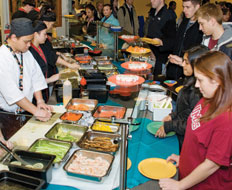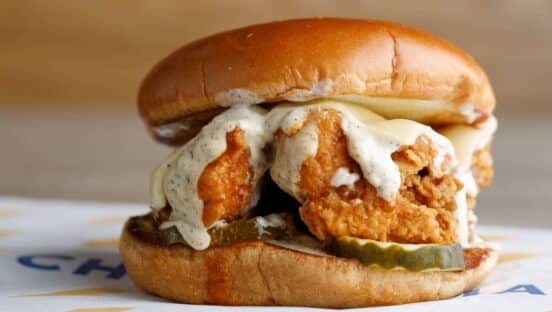In some ways, today’s college students aren’t much different than their predecessors.
They want to make the world a better place, get a good job, and live a great life.
But there have been huge changes along the way, particularly in the technology they use, the flavors they’ll try, and their familiarity with restaurants.
Current students have more varied tastes and understand value better—a result of the fact that going to restaurants, particularly in the limited-service arena, is second nature.
“This is a generation that grew up dining out regularly,” says Eric Giandelone, director of foodservice in Chicago for market research firm Mintel. “It’s not necessarily viewed as a special occasion. It’s an everyday habit.”
There are multiple reasons for this, including time pressures, particularly for families that have a single parent or dual-working parents.
“It’s also part of the casualization of the culture we have,” Giandelone says. “Eating out used to be dress-up occasions. Then came casual restaurants, and quick-service restaurants are even more casual. So it becomes more routine, more normal.”
Today’s crop of college students is in the middle of the Millennial demographic, also dubbed Generation Y, Generation Next, or Echo Boomers. The generation was born between 1980 and 2001 and has a population of 75 million in the U.S.
Millennials tend to be more flexible in their eating routines than older consumers, according to a study by the Hartman Group, a market research and consulting firm in Bellevue, Washington. They eat later, are impulsive on food choices, and like to dine with friends.
The study also found that 16–30-year-olds eat less meat than earlier generations and try new ethnic foods far more than Baby Boomers and Generation X.
When the Hartman Group broke down the survey further to look at college-aged Millennials, it found those aged 18–24 graze more during the day, are uncomfortable eating alone, and often consume vegetarian meals even though they still eat meat.
A separate study by Y-Pulse found some similar results. It also determined that young people are influenced by dining at limited-service restaurants, and found that many quick-serve attributes are expected in college dining facilities.
“They want good value on demand,” says Sharon Olson, cofounder of the Chicago-based youth-oriented food and beverage research and consulting firm. “They are willing to try new things, but they are very conscious of price and value.”
In a sense, there is a symbiotic relationship between limited-service restaurants and college dining. While quick-serves influence students’ eating habits, the new foods they try and learn about in college are likely to stay with them after they leave the campus.
“At college they are exposed to new friends, new cultures, new foods,” Olson says. “It’s a unique environment. You see more interest in the ethics of food, like the treatment of animals and triple-certified coffee, and that carries forward to some degree.”
In fact, the Hartman study found that going to college is a major trigger for changing food and beverage preferences among people ages 18–24, second only to becoming a parent.
This comes as no surprise to college-dining specialists.
“We’re a great opportunity to experience new foods,” says Ida Shen, assistant director, culinary, at the University of California at Berkeley. Students already have varied tastes when they arrive at college, “and they want to try a little bit of everything.”
Food that is sustainable and organic has come to be expected, she says.
Still, eating has to fit into their lifestyle.
“It’s an ‘I want it now’ type of generation,” Shen says. “They stay up late and eat at all hours of the night. They eat breakfast at all hours except breakfast.”
As a result, most universities have at least one dining facility open well beyond midnight, and all-day breakfast dining has popped up at a growing number of schools.
Across the country at the University of Massachusetts at Amherst, Ken Toong sees the same thing.
“The students are quite different from those who came before them,” says the executive director of dining and retail services. “The lifestyle has changed dramatically. With all the social media, with all the information readily available, this group is much more knowledgeable. And they want the best of everything.”
Dining directors strive to provide students with the best quality, diversity, and healthfulness of food, as well as various sites on campus to eat.
In addition to traditional dining halls, many campuses have a variety of quick-service food spots, grills, coffee shops, pizza parlors, and more. Some even host branded units such as Wendy’s, Chick-fil-A, Starbucks, and Red Mango.
“We do a little of all the services, from fast serve to almost gourmet,” says Scott Meyer, director of foodservice at the University of Texas at Austin. “The students’ expectations match the location. If it’s quick service, they expect instant service. They are willing to wait a little longer for fast casual and longer than that if we cook it for you.”
The University of Massachusetts even launched a food truck last fall. The truck offers gourmet burgers and operates until 2 a.m. or 3 a.m. daily. Toong may add two more trucks to offer other cuisine.
“Food trucks will be the next big thing for food on campus,” he says. “Ours is very popular, especially in high-traffic areas.”
Most campuses have at least one dining area with marché-style serving. Using the French word for market, marché dining employs various stations, such as stir-fry or pasta, where students line up for the particular types of foods.
“That style started building momentum a few years ago, and now it is expected,” says Zia Ahmed, senior director of dining services at Ohio State University, the nation’s largest campus. The style is deposing straight-line cafeterias.
[pagebreak]
“Students really want options,” Meyer says.
At Berkeley, the largest of the university’s four dining halls, Crossroads, serves 4,000 meals daily from the nation’s first organic-certified kitchen on a college campus. It features nine stations: deli, organic salad bar, comfort foods, vegetarian/vegan, grill, bakery, soups, pasta/pizza, and chef-prepared specialties from around the world.
“On any given day, there might be Mexican, Hawaiian, Thai, maybe German, or American,” Shen says. “We always have pizza, pasta, and deli, and we are always reevaluating our menus and want to give students what they want.”
The campus’ student body includes a huge population from Asian descent, so authentic dishes from China, Japan, Korea, Thailand, India, and other Far East countries are very popular.
“And Mexican food is comfort food, not exotic in any way,” Shen says.
These ethnic-based foods are popular all across the country. Sushi, tacos, and cooked-to-order stir-fry have become mainstream. Dishes like Vietnamese pho, Korean barbecue, and Indian tandoori chicken are attracting a growing following.
At the University of Colorado at Boulder, one dining hall features a Middle Eastern station. The Persian Ghaza prepares flatbread in a stone oven and kabobs on swords over a flaming grill, using locally raised lamb that is certified halal.
“Students’ taste buds are more sophisticated today,” says Ahmed, who is also past president of the nine-state Midwest region of the American Association of College and University Food Services. “They are growing up with all kinds of options.”
The popularity of various ethnic dishes isn’t just found at big universities.
When students at Washington & Jefferson College vote on menus at the main dining hall for the upcoming month, sushi and authentic Asian and Mexican cuisine are near the top.
“Sushi always gets picked,” says Aaron Weaver, general manager of dining services for Parkhurst Dining Services at W&J, a small liberal arts college of about 1,500 students near Pittsburgh. “It’s rather phenomenal how popular it has become.”
Allowing students to select their food, even to the point of choosing specific dishes, also is part of a growing trend.
“When I started in this 13 years ago, we basically did what we thought was best,” Weaver says. “Now, we have student dining committees, social media, and other ways students can tell us what they want. You have to listen or the college will find someone who will.”
Shen says social media makes this practice much easier at Berkeley. “We’re all about the students and what they want. We don’t read minds, and we’re doing everything, including social media, to get them to communicate easier.”
Most college students have cell phones and a majority have smartphones, making social media communication almost second nature. Mintel’s Giandelone says Millennials are far more comfortable than earlier generations using smartphones to learn about and order food.
Among the most vocal students are vegetarians and vegans, who combine for fewer than 15 percent of collegiates overall. “They usually let us know what they want,” Shen says.
The number of real vegetarians “is consistently about 6–7 percent,” Toong says. Flexitarians, those who eat mostly vegetarian but will also eat meat and fish, “probably boost that up above 10 percent.”
Still, dining directors note that a growing number of non-vegetarians are selecting meat-free items, particularly as the taste of those options improves. And gluten-free food also has become more popular.
Berkeley’s dining service recently added a registered dietician to help reach out to students, especially those with allergies, about healthier and safer eating. Numerous other colleges have looked at these issues, as well as at educating students about food sources.
“We know students want food that is more natural, fresh, and less processed,” Toong says. “They want it customized to their needs. But we also know student behavior. They eat healthier in the morning and drop their guard later in the day. So we have to help.”
As in the restaurant industry, Amherst campus-dining leaders have reduced sodium, replaced some traditional pasta with whole-wheat varieties, and made several cookies with whole grains, often without telling students. Additionally, contests promote healthier eating.
Part of the educational process also may include inviting visiting chefs to cook special items, hosting cooking classes, and helping students understand foods’ origins.
Duke University has an annual Local Ingredients Day. The event is sponsored by the university’s dining partner, Bon Appetit Management Co., and began as a way to educate students about the carbon footprint of the food they consume.
“We believe the role of dining service on campus is not only to provide great food and great service, but equally important is education and building community,” says Rick Johnson, assistant vice president of student affairs, housing, dining, and residence life.
Despite all the dining changes at universities, some things stay the same. Comfort foods remain popular, no matter how good or bad they may be for you.
Burgers are still very popular, as are chicken tenders and nuggets. Even PB&J, with various types of peanut butter and jelly, can draw a crowd.
Clam chowder remains big in New England, while barbecue and chicken-fried steak with mashed potatoes and gravy are winners in Texas. And chicken Parmesan and pierogies make the grade in western Pennsylvania.
“Students sometimes just crave those tastes from home,” says Texas dining chief Meyer.











